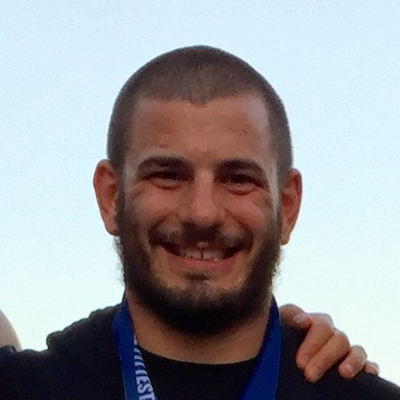
Get the breakdown of 15.3.
For the third week of the 2015 Reebok CrossFit Games Open, competitors were asked to complete as many rounds as possible in 14 minutes of 7 muscle-ups, 50 wall-ball shots and 100 double-unders.
This is the first time in the five-year history of the Open that a workout has started with muscle-ups. Consequently, to earn an Rx'd score on the workout, competitors who were 16-54 years old needed to get at least one muscle-up.
Let's take a look at how this played out in the CrossFit community.
Community Performance Breakdown
In total, 194,640 people submitted scores for 15.3.
Below, you can see where the Rx'd men and women finished the workout.

The 7 muscle-ups were like tar pits, capturing competitors and holding them there until the end of the 14-minute time cap. As you can see from the spikes at the start of each round, many athletes ended on the rings.
The majority of Rx'd men finished in the second or third round, while Rx'd women were relatively evenly spread between the first, second and third rounds.
Finishing in the fourth or fifth round was exceptional for Rx'd men and Rx'd women. Only two men and one woman reached the fifth round (629+ reps)—Ben Smith (630 reps), Brad Townsend (630 reps) and Sam Briggs (633 reps).
Here are the corresponding round and percentile tables.
| Round 1 | Round 2 | Round 3 | Round 4 | Round 5 | |
|---|---|---|---|---|---|
| Men | 12,272 | 26,351 | 25,791 | 3,027 | 2 |
| Women | 3,748 | 4,671 | 3,093 | 237 | 1 |
| Percentile | Score | |
|---|---|---|
| Men | 50th | 281 |
| 75th | 333 | |
| 90th | 398 | |
| 95th | 471 | |
| 99th | 496 | |
| Women | 50th | 171 |
| 75th | 316 | |
| 90th | 351 | |
| 95th | 404 | |
| 99th | 475 |
Muscle-up Watch
If an athlete scored 1 rep, or even 2 or 3, odds are good we may be witnessing their first-ever muscle-up(s).
There are thousands of athletes who fall within this range. Joining them are many athletes who had at least one muscle-up before the release of 15.3, and put in a hard-earned Rx'd score.
This is pretty incredible.
| 1 | 2 | 3 | 4 | 5 | 6 | 7+ | |
|---|---|---|---|---|---|---|---|
| Men | 2,186 | 1,137 | 861 | 736 | 625 | 512 | 61,388 |
| Women | 992 | 473 | 360 | 316 | 269 | 180 | 9,160 |
To get a sense of how much competitors have improved at muscle-ups over the years, I found the athletes who didn't have a muscle-up in 13.3 (the 12-minute AMRAP of 150 wall-ball shots, 90 double-unders and 30 muscle-ups), or 14.4 (the 14-minute AMRAP of 60-calorie row, 50 toes-to-bars, 40 wall-ball shots, 30 cleans and 20 muscle-ups), and checked whether they logged an Rx'd score on 15.3.
More than 10,000 people (7,950 men + 2,388 women) who did not have a muscle-up last year for 14.4—at least not under fatigue—got at least one muscle-up in 15.3.
Below, you can see the breakdown of the number of people for whom I've got both a 14.4 score and a 15.3 Rx'd score, the latter meaning they have at least one muscle-up now. I show how many did not have muscle-ups in 2014, meaning a score of 180 reps or less on 14.4, and do have them now.
| Division | Have Score from 14.4 | Have Score < 180 in 14.4 | Have Score = 180 in 14.4 |
|---|---|---|---|
| Men | 37,714 | 12,079 | 7,950 |
| Women | 8,709 | 3,514 | 2,388 |
Below I show the analogous table for 13.3, which tells a similar story. Nearly 4,000 athletes (2,141 men + 1,655 women) who did not have a muscle-up two years ago for 13.3 logged at least one muscle-up in 15.3.
| Division | Have Score from 13.3 | Have Score < 240 in 13.3 | Have Score = 240 in 13.3 |
|---|---|---|---|
| Men | 17,977 | 6,436 | 2,141 |
| Women | 5,194 | 1,731 | 1,655 |
On the other side of the coin, we can look at those who chose to do the scaled version of 15.3, presumably because they just don't have a muscle-up yet. Eighty-five percent of the women's field opted for the scaled version of 15.3, as did nearly 40 percent of the men.

Relationship Between Height, Weight, Age, Experience and 15.3 Performance
These following four plots explore the relationship between 15.3 score and the self-reported info gathered from Games site athlete profiles (here's an example), namely height, weight, age, and CrossFit experience level. They each consider the Rx scores only.
For the men, you see a pretty clear story: it's not a bad workout for tall guys, probably because of those wall balls, but you best not be too tall. Then, it's good to be 180 - 190 lb., big enough that that ball's pretty light. It's good to be young (20 - 25), and experienced in CrossFit.
The women's scores tell a similar story: you can't be too light or too heavy, height doesn't seem to matter all that much inside the extremes, and experience helps. But the age pattern for women is different, where the best average 15.3 score goes to the 25-30 year olds.
height

Weight

Age

Experience

Updated March 19 at 9 a.m. PT: Replaced the age plot with one that includes athletes 50 - 55 years old.























